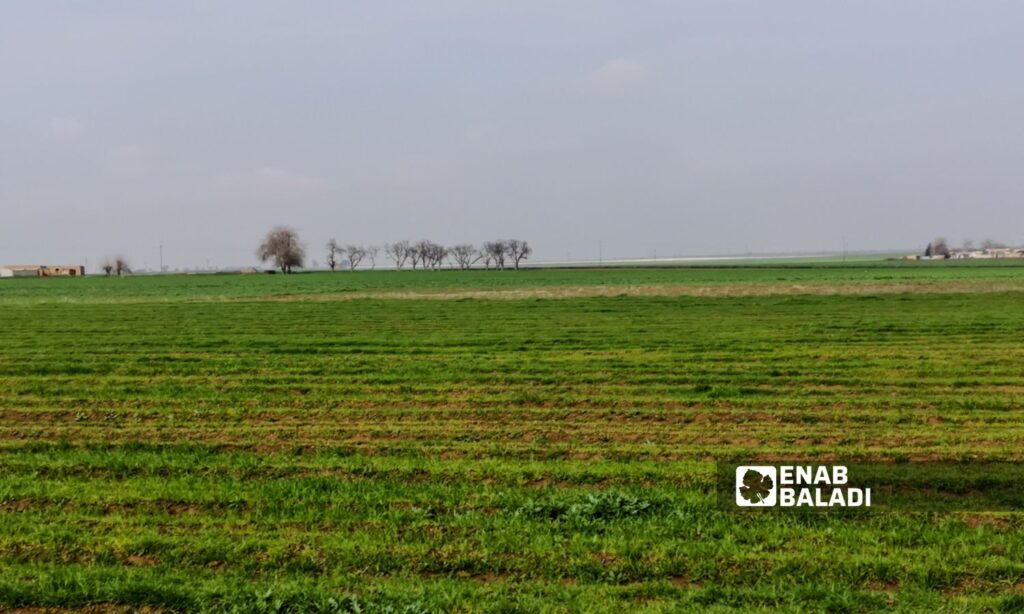Enab Baladi – Ras al-Ain
This winter season, the area of Ras al-Ain, located northwest of al-Hasakah, witnessed heavy rainfall, the densest in years, which rejuvenated the farmlands, promoting the dense growth of pasture grasses—a sign heralding an abundant agricultural season for wheat and barley crops.
Despite the many benefits brought about by the heavy rainfall, it poses a risk to certain crops, such as cumin and other aromatic plants, which do not tolerate high humidity and may rot and get damaged as a result.
The rainfed lands flourish
Rainfed lands in Ras al-Ain primarily rely on rainfall due to the lack of artesian wells for irrigation as a result of the receding groundwater in the area. The recent rainfall has contributed to the growth of plants and agricultural crops.
Adnan Ismail, from the village of Abu Jaloud west of Ras al-Ain, said that their agricultural lands depend entirely on rain due to the receding groundwater levels in the western countryside of Ras al-Ain.
He explained that this year’s heavy rains have fully improved the agricultural situation in his village, creating job opportunities for those working in agriculture as well.
Ismail planted 100 dunams of wheat and 60 dunams of barley thanks to the heavy rain that his region experienced. He noted that if the rainfall continues, it will yield a plentiful season for both wheat and barley.
Mazen al-Sayed, a resident of the village of Hamid, considered the rains to have saved him from significant costs due to his inability to afford the installation of a solar energy system to operate his well, relying instead on a diesel engine to irrigate his 126-dunam barley field. This process can take days to irrigate the entire land, requires significant amounts of diesel, and poses a financial burden, as the price of a diesel barrel reached 150 dollars—a cost he cannot fully cover for all his irrigation needs.
He mentioned that the rainfed barley currently requires one rainfall in March, and if that fails to happen, he will start the well and use it as an alternative source of irrigation to protect his crop from drought.
Cumin, a farmer’s choice
Cumin is one of the most important winter crops in Ras al-Ain due to its ease of marketing and high price. However, the crop can be significantly damaged by heavy rainfall, which can lead to the formation of water pools in the fields, rotting and damaging seeds. Excessive rains can also increase soil moisture levels, putting the plant roots at risk of fermentation and decay.
Mazen Maasum, a farmer from the village of Alouk east of Ras al-Ain, said that he cultivated an area of 70 dunams with cumin this year. He noted that his cumin crop was not affected by the heavy rains earlier due to his delayed planting until mid-January.
He pointed out that the real danger to the cumin crop lies in the upcoming three months, during the root growth phase, as cumin is sensitive to high humidity and heavy rainfall.
200 Thousand dunams benefited from the rains
The head of the agriculture office in the local council, Omar Hammoud, told Enab Baladi that the rainfall had a positive impact on the agricultural and pastoral conditions, especially in areas suffering from water scarcity in the western countryside.
About 200,000 dunams of rainfed lands, which depend on the rainy seasons, have benefited from the weather conditions. Thus far, the Directorate of Agriculture has not recorded any damage to the agricultural crops.
Hammoud stressed the need to monitor crops like cumin, anise, and fava beans against heavy rainfall in the coming period and to provide fertilizers and regular cleaning, especially after the root growth stage.
Agriculture, along with livestock breeding, is one of the primary professions engaged in by many residents of Ras al-Ain and serves as a major source of their income.
Agricultural crops in Ras al-Ain face difficulties with marketing and merchant control, compounded by the absence of government bodies to purchase strategic crops as was the case in the previous wheat season.
Ras al-Ain is located along the Turkish border and is controlled by the Turkish-backed Syrian National Army (SNA). Meanwhile, fronts of conflict with the Syrian Democratic Forces (SDF) surround it and Tal Abyad, with the Turkish border serving as its only outlet abroad.

